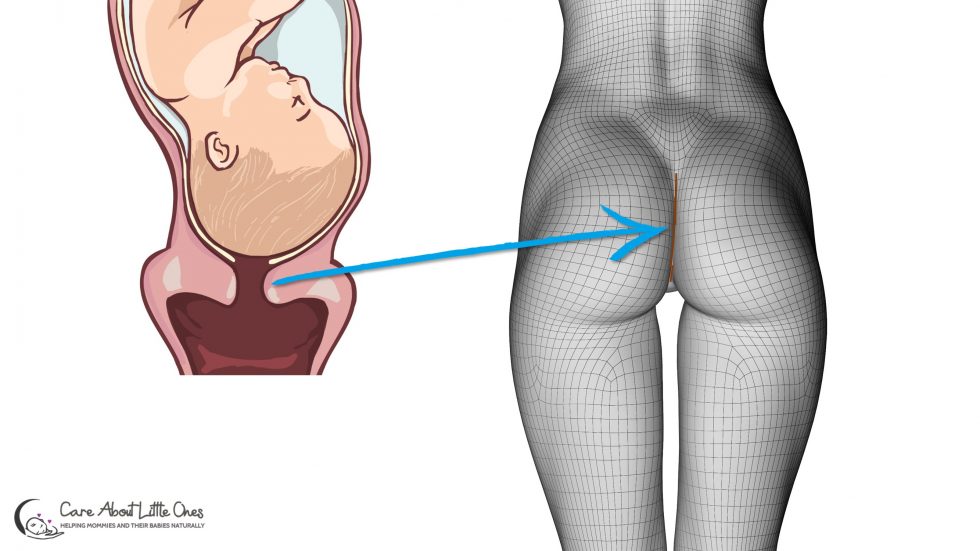The Purple Line – Find Out If You Are Dilating

There is no doubt that the most reliable way to tell, if you are dilating and also how much you are dilated is a vaginal exam. However, a vaginal exam is neither a very pleasant experience nor always an option.
Luckily, your body itself MAY be able to tell you, if you are dilating (and some women may even get a ROUGH IDEA about how much you are dilated).
You just need to know where to look and how to interpret what you see!
One of the most remarkable ways in which your body MAY be able to tell you that you are dilating is the so-called Purple Line! It is a purple or brownish line (mostly depending on skin color) that extends from a woman’s anus upwards to the top of the cleft between her buttocks!
To be precise, it does not appear in all women! According to research, it appears in about 76% of all women when they are dilating (1).
However, from our personal experience, we very much doubt that 76% of women develop a purple line.
We’d rather say that 76% of women do NOT develop a purple line. But this may be a question of ethnicity.
So, what does the purple line mean?
What Exactly is the Purple Line?
The following graph is an illustration of the purple line and where exactly it can be found:

According to research (1), if a woman has a purple line, it is likely that she is dilating.
Of course, as always when it comes to scientific studies, it is difficult to say if the findings apply to EVERY woman in this world. Most of the times, they do not…
That said, so far, we only had 4 cases of women who were not dilated although they had a purple line.
Given that the purple line is visible in your case, then you would see it close to your anus first and then extending upwards to the top of the cleft between your buttocks. In the final stage, the purple line will usually be approximately 10 cm in length.
Scientists are still indifferent, as to why a woman’s body may develop a purple line.
However, what they did find is that there seems to be a medium positive correlation between the length of the purple line and the cervical dilation.
If that were true, it would mean that we could get a VERY ROUGH idea about how much a woman is dilated, based on the length of her purple line.
In fact, one study came up with the following table which shows the average length of the purple line of the women in that study, given their cervical dilation (1). The numbers in brackets are the standard deviations.
| Cervical Dilation | Mean Length of Purple Line (SD) |
| 1-2 cm | 5.3 cm (3.1 cm) |
| 3-4 cm | 7.8 cm (3.4 cm) |
| 5-6 cm | 7.8 cm (2.4 cm) |
| 7-8 cm | 8.7 cm (2.2 cm) |
| 9-10 cm | 9.6 cm (2.1 cm) |
How to Interpret the Length of the Purple Line
As already mentioned, the two numbers, length of purple line and cervical dilation, are not perfectly correlated. Therefore, we cannot say that if a woman’s purple line is, say, 1cm long, her cervix is 1cm dilated.
Instead, as we can see from the table above, the purple line may be as long as 5.3 cm, when a woman is only just 1-2 cm dilated.
Now, the bold numbers in the table are average numbers across all 109 women of that study who developed the line.
(To be precise: actually, we are talking about the mean here, not the average, which – from a statistics point of view – is not exactly the same).
The numbers in brackets, on the other hand, are the so-called standard deviations. These numbers tell us how much, on average, the length of the purple line – that was measured during the study – deviated from the average value (the mean). And as we can see, the standard deviations are quite high.
So for example: at a dilation of 1-2 cm, the purple line was 5.3 cm on average across all 109 women. However, the standard deviation was 3.1 cm and thus very high compared to the average value.
What this means is that, at a dilation of 1-2 cm, the length of the purple line of the women of the study, was not necessarily close to 5.3 cm.
Instead, some women may have had a purple line of 2.2 cm, some may have had a purple line of 3.1 cm, some may have had a purple line of 7 cm, and others may have had a purple line of 6.4 cm etc., when their cervix was about 1-2 cm dilated.
In other words, it is very difficult to conclude from the length of the purple line how much a woman is dilated.
Nevertheless, normally, we see a trend. And that trend (normally) tells us that the longer the length of the purple line, the more the cervix seems to be dilated.
However, as already mentioned, please keep in mind that there will also be women who have a very long purple line, although they are not dilated at all. This is to be expected – given the large standard deviation values.
So, at best, we get a VERY ROUGH idea about how much the cervix is dilated, given the length of the purple line.
So, How can You Tell How Much You Are Dilated?
Well, of course, the most reliable method is definitely to have a vaginal exam. But as already mentioned that’s not always a viable option.
An alternative approach is to take into account another approach, not just the Purple Line alone, to estimate how much you are dilated.
For that purpose, some midwives make use of the Fundus Theory. Just keep in mind that the Fundus Theory can only be applied when you are in active or transitional labor.
But to be very clear, the Fundus Theory is not science based at all, so we don’t know how accurate it is for the general public. However, we know that it was pretty accurate in many women that we personally know when they were dilating (including in our own case).
The reason why we mention the Purple Line approach together with the Fundus Theory is because if looked at them separately, both, the Purple Line and the Fundus Theory alone may not be a great help if you cannot confirm the number (how much you are dilated) somehow.
However, when you look at the combined information that BOTH approaches tell you, that’s when you may get closer to the actual number how much you are dilated.
If you want to know more about the Fundus Theory, check out the following video in which we explain both, the Purple Line and the Fundus Theory:
Want to learn 2 breathing techniques for your labor?
Check out what you will learn in our FREE Mini Birthing Course! and sign up for it!
Sources
Shepherd, S. Cheyne, H. et al. (2010): The purple line as a measure of labour progress: a longitudinal study. In: BMC Pregnancy Childbirth. Sep 16; 10:54. doi: 10.1186/1471-2393-10-54. https://pubmed.ncbi.nlm.nih.gov/20846387/
Medical Disclaimer: The information on this page is not intended to diagnose, prevent, mitigate, treat or cure any disease! It is not personal medical advice. We recommend that you ask a doctor whenver you are looking for medical advice!
ABOUT THE AUTHOR
Nathalie Kaufmann & Mathias Ritter
Nathalie is a pregnancy and birth Consultant and a TCM Therapist with almost 20 years of experience in Traditional Chinese Medicine (TCM), acupuncture, reflexology, Shonishin baby massage techniques, Western and Eastern massage techniques (including TUINA), as well as herbal medicine and nutrition.
She has worked in hospitals across London and was Head of the Maternity Acupuncture Clinic at the Whittington hospital in London. Today, Nathalie runs her own practice in London and helps pregnant women with pregnancy- and birth-related issues. She also specializes in alternative treatments for babies and children.
Mathias is a Researcher and Science Geek who holds two Master of Science degrees. He has been involved in several health-related businesses over the past 10 years and has held presentations about health-related topics across Europe. He specializes in research regarding pregnancy-, birth and baby-related topics.
RELATED POSTS
How to increase the Oxygen Supply to the Baby in the Womb
During your pregnancy, there is a constant supply of oxygen to your baby. But what pregnant women often don’t know is that there are certain things that can reduce the oxygen supply to the baby. Luckily though, there are also very simple ways to increase the oxygen...
Best sitting Position to help Baby find a good Position in the Womb
As they approach the end of their pregnancy, many moms-to-be start to worry. How should they help baby find a good position for labor? What about turning baby head down? What if baby is posterior? And how should I help baby engage in my pelvis?So, how can you help...
Pregnancy Vitamins: What Nutrients does a Fetus need & what Foods should I eat?
This blog post adds to our video on youtube in which we go through our list of the 9 most important micronutrients every fetus needs. If you have not watched our video so far, we recommend doing that first:Below, you can find a list of all the nutrients that we...
How to keep moving with an epidural
This blog posts adds to the video "8 reasons why labor can stall and what to do about it". In that video, among others, we explain the "roll-over technique from Penny Simkin (see sources below) which allows a woman to keep moving even when she is confined to bed....
How to keep track of Baby’s Movements
If your baby is active in your womb, then it is a sign that your baby is well. Because of that, most doctors recommend counting your baby's kicks from week 28 of your pregnancy onwards. In this brief blog post, we want to explain how you can keep track of your baby's...
How to relieve Pelvic Girdle Pain during Pregnancy
This blog post complements the information from our video on youtube on how to relieve pelvic girdle pain during pregnancy. In that video, we propose 2 ways to relieve pelvic girdle pain: 1. some minor changes in your lifestyle and 2. exercises. While the video...
Are you a good candidate for VBAC?
This blog post is intended to provide additional information apart from what we have mentioned in our video with the title "are you a good candidate for VBAC?" Moreover, on this page, you can find the entire list of scientific research studies which this video is...
How Effective Is Reflexology to Induce Labor?
Many women in their late pregnancy hope that reflexology can help them induce labor naturally. And indeed, reflexology is ONE of the tools that I apply to help women go into labor.So, how effective is reflexology to induce labor? Reflexology could help you induce...
Best Sleeping Position To Turn A Breech Baby (with Pictures)
Most babies turn at night. But unfortunately, not every sleeping position provides the baby with enough room to turn. As a result, many babies remain in a breech presentation. Luckily though, sleeping in the right position can support baby turn head down.So, what is...
LEAVE A REPLY











I’m 1 cm dilated with a purple line very dark and all the way up the crack so count me in for your numbers of women with long purple lines but next to no dilation.
I am only 34.5 weeks so I have not had a cervical exam yet, but I do have the purple line all the way up my crack. We will see how accurate this is at my first cervical exam in 2 weeks.
Thank you for sharing this information. Well done. I am a birth doula, and I will use this information when I support my clients.
Thanks so much for your lovely comment Victoria! We are very happy to hear that you find our content helpful! 😉